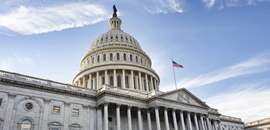The past four years have been one of the most politically-contentious periods in U.S. history. It started with the Mueller investigation of the 2016 election, was followed by impeachment proceedings of President Trump in late 2019 and early 2020, and then culminated with this year’s contested presidential election.
Yet, amid all of this, the U.S. stock market did not skip a beat. The S&P 500 Index rose by more than 65% between the two presidential elections, and it set record highs in November even though President Trump lost the election.
This begs the question: Why are investors so willing to overlook important political developments?
Before this year, the standard explanation was investors viewed what was happening in Washington, D.C. as a sideshow: They did not believe Trump would be ousted from office, because Republicans controlled the Senate and a two thirds majority was required to remove him.
However, the rationale changed during this year’s election campaign when polls indicated Joe Biden was well ahead of Trump and there could be a “blue wave” sweep of Congress. The stock market continued to advance as investors reasoned the economy would benefit from passage of a Democrat-sponsored plan to extend key provisions of the Cares Act that expire at the end of this year.
My own take is these arguments belie a more fundamental consideration: Namely, over the long-term the stock market is primarily driven by the performance of the economy and most of the time politics plays only a marginal role.
The principal exception in the post-war era was the election of Ronald Reagan in 1980. It marked an end to the stagflation of the 1970s and ushered in a period of strong economic growth and low inflation. Key policy changes included corporate and personal tax cuts, deregulation of businesses and Federal Reserve actions to bring inflation under control.
Four years ago, many investors viewed Donald Trump’s surprise win as a potential “game-changer” as well. The reason: Trump’s economic policies were similar to Reagan’s, and they had a good chance of being enacted because Republicans gained control of both houses of Congress. The stock market soared in the first year amid optimism that economic growth of 3%-3.5% per annum prior to the 2008 global financial crisis would be restored.
Looking back over what ensued, however, it is hard to differentiate the performance of the economy in the Trump era from the Obama years. Growth of real GDP averaged about 2.5% per annum prior to the COVID-19 pandemic, which was only slightly above the prior trend. Moreover, the pace of jobs creation over the past decade was fairly steady as the unemployment rate fell from 10% to a record low of 3.5%.
It is not surprising, therefore, that the performance of the stock market in the Trump era was similar to that during the Obama years. It remains to be seen whether the results during the Biden administration will be equally good considering market valuations are elevated today.
| STOCK MARKET | Jan 20, 2009 - jan 19, 2013 | jan 20, 2013 - jan 19, 2017 | nov 8, 2016 - nov 3, 2020 |
|---|---|---|---|
| U.S. (S&P 500) | 19.1 | 13.5 | 14.3 |
| Russell 2000* | 21.5 | 12.3 | 9.3 |
| NASDAQ | 22.9 | 16.8 | 22.5 |
| International (EAFE $) | 14.7 | 4.2 | 6.2 |
| Emerging Markets (MSCI $) | 23.5 | -1.9 | 8.5 |
| U.S. Bond Market | JAN 20, 2009 - JAN 19, 2013 | JAN 20, 2013 - JAN 19, 2017 | NOV 8, 2016 - NOV 3, 2020 |
|---|---|---|---|
| Treasuries | 3.4 | 1.1 | 3.7 |
| IG Credit | 10.2 | 2.6 | 5.4 |
| High Yield | 20.8 | 5.2 | 5.7 |
Leading up to this year’s elections, investors focused on Biden’s fiscal plan, which is the polar opposite of what the Trump administration implemented. If enacted, it would likely boost federal spending to 24% of GDP by 2030 from 21% in 2019. The priorities include green infrastructure projects and increased R&D for clean energy and technology, as well as expansion of Medicare eligibility and the Affordable Cares Act.
To help finance increased federal spending, Biden will likely roll back the Tax Cut and Jobs Act (TCJA), the signature legislation of the Trump presidency. Key features of Biden’s plan are the corporate tax rate would be increased to 28% from 21%. On the personal side, households with adjusted gross income (AGI) of $400,000 or less would not see their taxes increase directly. In addition, the marginal tax rate on capital gains and dividends would be nearly doubled from 24% to 43%.
In the wake of the elections, however, many investors believe the prospect of achieving such broad-based changes is low. The reason: If Republicans maintain control of the Senate, they are likely to block tax hikes and large-scale government spending. What appears more attainable is an agreement with Congressional Republicans to pass a relief bill that will be considerably smaller than the one that House Democrats passed in October.
Viewed from this perspective, investors realize many of Biden’s policy initiatives are unlikely to be implemented if gridlock ensues. That is why the two runoff elections in Georgia for the Senate on January 5 are of special significance, as they will decide which party controls the Senate.
Meanwhile, the economy’s performance in the coming year will largely be shaped by developments related to COVID-19. The main concern in the near term is the recent spike in cases and hospitalizations will lead to targeted shutdowns of businesses that could impede economic recovery. As a result, some forecasters now envision growth turning negative in the first quarter, which could spawn a market pullback.
Longer term, however, the economy stands to benefit from the development of vaccines that should enable conditions to normalize by mid-year. My own take is the U.S. economy has proved to be highly resilient to shocks in the past two decades, and the prospects for 2021 are generally favorable if the economy continues to recover from the worst pandemic in 100 years. For this reason, we are not altering our investment strategy that maintains a moderate overweight in risk assets.
A version of this article was originally posted to Forbes.com on December 1, 2020.


















